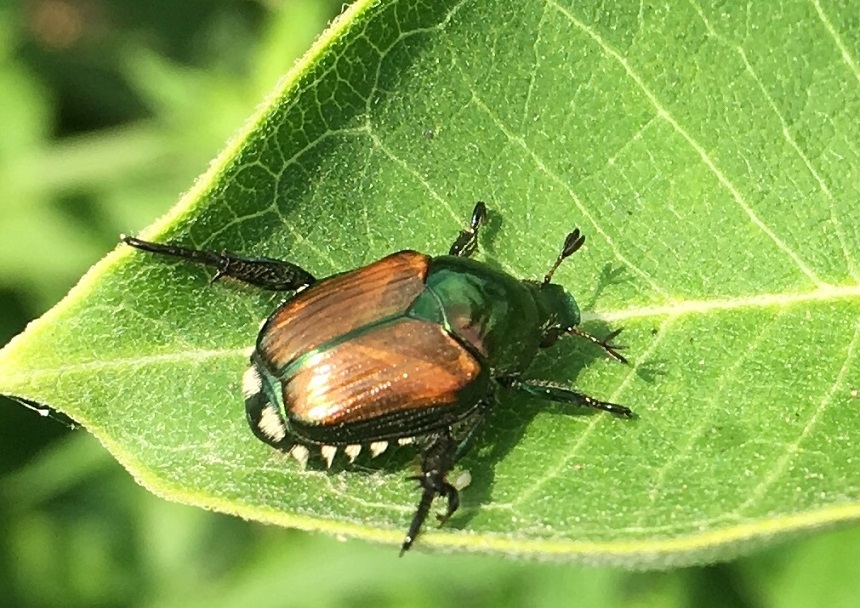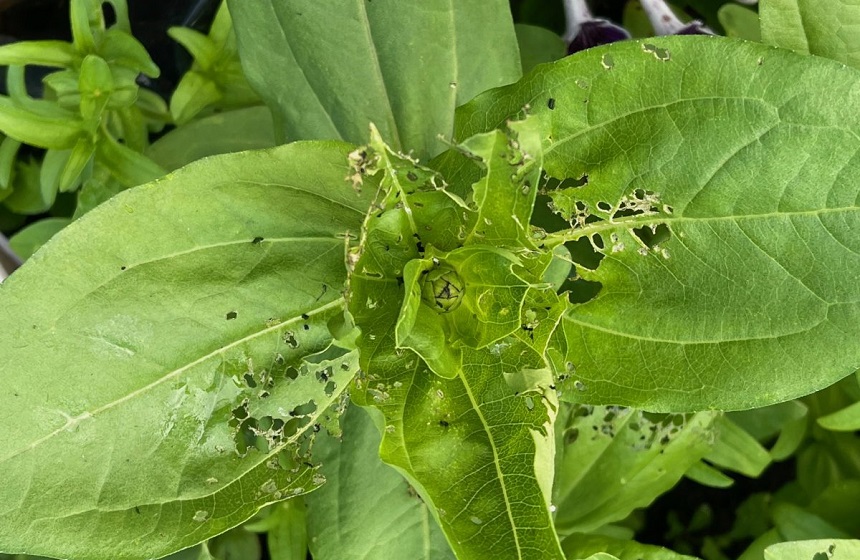

Japanese beetles are a dreaded summer garden enemy. These insects can easily destroy a garden over the course of a couple of months. These pests are drawn to plants like roses, hibiscus, raspberry bushes, and fruit trees. These insects came to North America from Japan in the early 1900s, and they are most common east of the Mississippi.
If you have this unwelcome insect in your yard and garden, you might be searching for how to get rid of Japanese beetle. There are so many different plants that these insects like to consume that many of your plants might not be safe if Japanese beetles have moved in. This guide will help you to learn more about this insect and how to eliminate them for good.
Japanese beetles (Popillia japonica) are very recognizable. They are an iridescent green beetle that are small in size, but the damage that they can do is not small. This insect is classified as a predator for hundreds of different plants, and they are one of the major insect pests in the eastern and midwestern United States.
Brought to the US in the early 1900s, this beetle begins its life cycle in the ground as a 1-inch white grub. They can be tough on lawn health before they mature and start attacking other plants in your yard. Their lifecycle only lasts about 40 days, but they can do a lot of damage after they have hatched and begun growing to adult size.

As mentioned above, the Japanese beetle is a shiny, bright green. They are not big, but they are quite noticeable because of their shiny exterior. When they are in their grub stage, they are 1 inch in length, white, and c-shaped. You can often spot Japanese beetle grubs in dead spots in your lawn before they have matured into beetles.
The mature beetles might appear copper-colored in the shade, and they have tan wings, which are readily noticeable on most plants. Their blue-green heads are shiny and noticeable in nearly any kind of light.
The signs of Japanese beetle damage are often quite distinctive as very few insects can cause so much damage in such a short period of time. The way that they eat plants is also highly distinctive and cannot be mistaken for any other insect’s work.

Leaves and flowers that have been eaten by Japanese beetles often appear lacy since all that is left is the skeleton of the leaf or flower. This skeletonized appearance can appear overnight because these beetles work very fast once they have matured from their larval stage. These insects work fast, and they eat nearly constantly, so you will probably spot beetles hard at work near any leaves or flowers that have this skeletal appearance.
In grub form, Japanese beetles are just as voracious. They cause dead spots in people’s lawns as they consume the blades of grass after they hatch. Brown patches in the lawn are often the first telltale sign that you are dealing with a Japanese beetle infestation that needs immediate attention. Japanese beetles can also prey upon shrubs and other plants near the lawn in their larval phase, turning them brown as well.
Earwigs generally do a similar damage to your property, so if you encounter them, we’ve got you covered in our guide on the best earwig killers.
One of the most effective ways to get rid of Japanese beetles is to hand-pick them. This is time-consuming and a little tiring, but it can be the easiest way to get rid of the adult Japanese beetles in your garden. You will want to make a bucket of soapy water to drop them into. This is the best way to get rid of Japanese beetles using a non-chemical method.
This is also one of the best ways to get rid of Japanese beetle on delicate plants like Zinnias. If you have been struggling with the idea of how to get rid of Japanese Lady Bug beetles, this is the fastest and most environmentally-friendly way of doing so.
Japanese beetle traps are one of the most effective ways to remove this pest from your yard or garden. This is also a really effective way to get rid of Japanese beetle bugs in your house. These traps are baited with a pheromone that attracts them and makes them want to get inside the trap. One of the downsides to this method of removing Japanese beetles off your house faster is that the pheromones in these traps can actually draw in Japanese beetles that are residing in other people’s yards too. This can make it tough to grapple with the problem, and your traps might be overwhelmed.
If you have been wondering what is the best way to get rid of Japanese beetle larvae and it is also a great way to get rid of Japanese beetles on flowers. Repellants are not a natural method of removing these pests, but they can be very effective. You can buy insecticides and repellants at local gardening stores or home improvement stores, or you can elect to make your own.
You can make your own homemade repellant out of 1 tsp of liquid dishwashing detergent and 1 cup of rubbing alcohol. Add this to 1 qt of water. Make sure that you shake well before applying it to your plants. Do not overdo it as this can be hard on your plants as well as the insects.
Row covers are another great solution for Japanese beetle prevention. These covers will protect plants that you do not want to be exposed to Japanese Beetles during their 6 to 8-week feeding frenzy. This can be a tough solution to apply for something like getting rid of Japanese beetles on Roses and other flowering plants. It is a much better solution for gardens and shrubs that are not very tall.
Neem oil is a really effective product that, besides Japanese beetles, also knows how to get rid of mosquitoes. Neem oil contains potassium bicarbonate which is particularly effective on roses and other flowering plants. Adult beetles ingest the chemical and pass it along in their eggs. This kills the larvae before they can hatch, breaking the lifecycle of the Japanese beetle and other insects you want to remove from your yard. This much be reapplied after a rainstorm, and you need to be sure not to expose fish to this substance since it is toxic to them.
Another great non-toxic solution for removing Japanese beetles is a bug vacuum. This is also a great way to deal with other slow-paced insects like ants. However, if you’re dealing with insects that won’t sit and watch you approach them with a vacuum, take a look at our best electric fly swatters.
This is an interesting solution to a Japanese beetle problem. When you choose to use the milky spore solution, you will actually introduce a fungal disease into your lawn to control the larval stage of the insects. The grubs will ingest the spores as they are feeding on the soil. This solution will also last for years in the soil, but it is quite expensive and time-consuming to implement.
The prevention of Japanese beetles can be easier than you might think. If your area is prone to this problem, prevention measures are key to keeping your Japanese beetles situation under control. A combination of these preventatives can be the right solution in some cases, but you might also be able to use just one of these prevention methods in your yard.

There are certain plants that Japanese beetles are not interested in feeding on. Other plants like geraniums can cause the beetles to be paralyzed, which allows them to be eaten by predators before they can damage your plants. These plants do not have to be the only ones that you use in your yard, but adding them throughout can help discourage these pests.
When grubs start to show up in spring and fall, you will need to remove grubs from your lawn. The grubs will start to surface if you make them uncomfortable early, and this will lead to birds eating them and taking care of the problem for you. Spraying your lawn with liquid dish soap dissolved in water can make it easy to bring grubs out of hiding.
These helpful parasitic friends can be applied when the grubs are small. They will attack the grubs and end the threat of Japanese beetles in your yard before it can become an issue in the first place.
While regular wasps will be no help to you in your fight against Japanese beetles, parasitic wasps (Tiphia vernalis or T. popilliavora), will actually eat the larva of the Japanese beetle. They will not help with the adult beetles, but they can take care of your larvae with ease.
There are various other insects that prey on Japanese beetles as well as birds. Parasitic wasps, nematodes, and some other insects can help control your Japanese beetle population with ease. When you bring your grubs out of the lawn with the right lawn treatment, birds will be more than happy to help clean up the invading insects, but you might want to ensure that you are killing larvae as well as beetles.
Japanese beetles do love roses. This can be one of the most frustrating things that Japanese beetles can do to people’s gardens. Roses can take a long time to recover from a Japanese beetle attack, and in some cases, they might not make it through the attack. Roses can be quite fragile, so preventing Japanese beetles from damaging them is critical.
Japanese beetles can be very frustrating to deal with because they can cause so much damage to your yard and garden. Once you have an established population of Japanese beetles in your yard, you might not be able to do anything but sit back and wait for their six-to-eight-week life cycle to end. We hope you will find these tips on how to get rid of Japanese beetle in your garden useful.